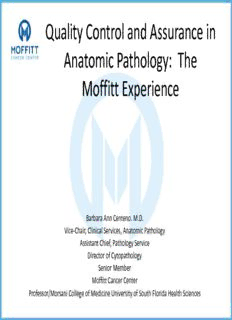
Quality Control & Assurance in Anatomic Pathology-Barbara Ann Centeno, MD PDF
Preview Quality Control & Assurance in Anatomic Pathology-Barbara Ann Centeno, MD
Quality Control and Assurance in Anatomic Pathology: The Moffitt Experience Barbara Ann Centeno. M.D. Vice-Chair, Clinical Services, Anatomic Pathology Assistant Chief, Pathology Service Director of Cytopathology Senior Member Moffitt Cancer Center Professor/Morsani College of Medicine University of South Florida Health Sciences QUALITY CONTROL AND QUALITY ASSURANCE • Quality control is a system for verifying and maintaining a desired level of quality in a test or process. Quality control practices span the entire testing process, from collection to the time the clinician receives the report. • Quality assurance is defined by CAP as systematic monitoring of QC results and quality practice parameters to assure that all systems are functioning appropriately. QA is the coordinated effort to bring together the various activities in the lab that are designed to detect, control and prevent the occurrence of errors. Changing Times • Change to pay for Quality • Patient empowerment • Reduced tolerance of error When things go wrong in pathology Test cycles • Pre-Analytic – Specimen collection and fixation, specimen delivery, specimen identification, adequacy of clinical history, accessioning • Analytic – Frozen sections, gross processing, histology processing, final diagnosis • Post-Analytic – Transcription, verification, report delivery, incomplete report, correlation of diagnostic finding is what ancillary studies Error rates in each cycle • Pre-analytical – Wrong-identification:27-28% • Most often discovered by clinicians – Defective specimens: 4-10% • Analytic – Misinterpetations: 23-29% • Most often discovered by pathologists • Post analytic – Defective report: 29-44% • Discovered by clinicians and pathologists Am J Clin Pathol 2008;130:238-246 Pre-Analytical Errors • Patient misidentification • Specimen misidentification • Collection and fixation of specimen • Clinical history • Transport • Accessioning Am J Clin Pathol 2008;130:238-246 Analytic Phase Reducing Errors and Improving Interpretative Diagnostic Accuracy • Depends on the pathologist’s ability to interpret morphological findings • The pathologist’s knowledge, training and experience or expertise • Utilization of standardized terminology and diagnostic criteria • Clinical correlation • Utilization of confirmatory diagnostic ancillary studies • Additional examination of cases: secondary review process Post-Analytic Phase • Proofreading • Report completeness • Report Delivery to clinician • Communication of critical/urgent results • Communication of additional ancillary findings Quality Control Processes in AP • Focused professional practice evaluation for first 3-6 months of new hires; ongoing professional practice evaluation • Second expert review all new Moffitt patient’s pathology • Tumor board presentations • Policies regarding consultations – managing major errors • Synoptic use mandated • Daily Microscope rounds for consensus • Formal intradepartmental consultations • Monthly QA meeting (mandatory) • Identification and monitoring of key pathology indicators (0ngoing) • Monthly Pathology Mortality and Morbidity Rounds (2014) • Creation of Pathology safety Committee (2014) • Critical Incident Review • Use of external Proficiency testing and reviews in cytology • Use of customer (clinical faculty) satisfaction surveys
Description: